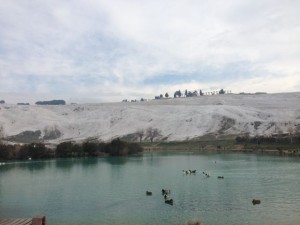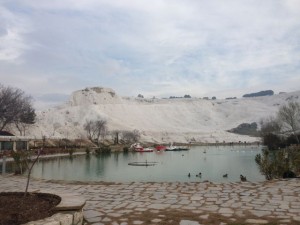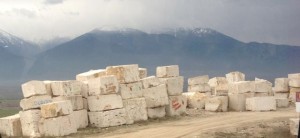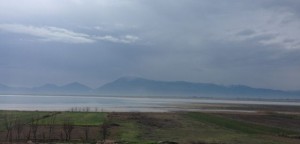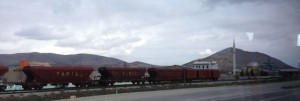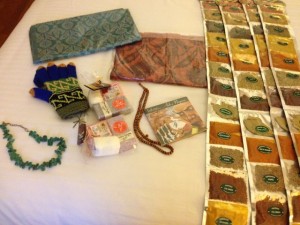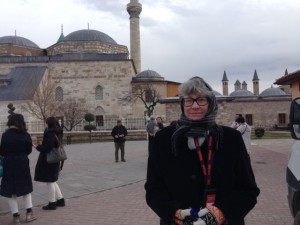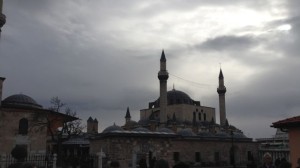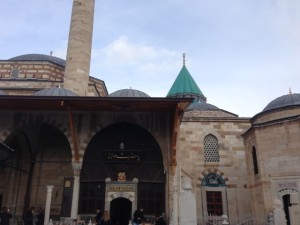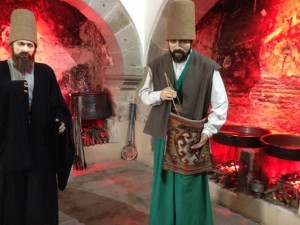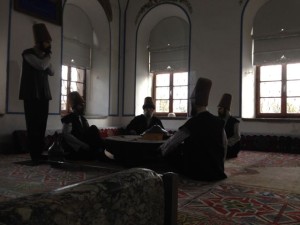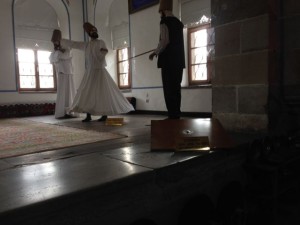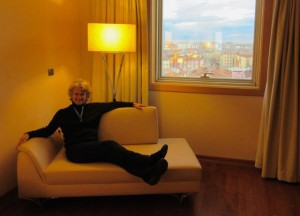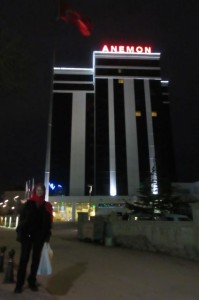Our first stop is at the artificial lake at the bottom of the hill so that we can take pictures of Pamukkale the cotton castle.
Although the lake has been there for centuries receiving the water that falls off the hill, the swan boats are on the chintzy side. There are vendors everywhere, and I bought a malachite necklace for 25 Tl or $10. Hard to resist such local treasures
Today we drive 5 hrs across Central Anatolian plain, a flat land growing potatoes, onions sugar beets, cherries, and wheat. The Silk Route came through here beginning 200 BC from China and reaching 4 thousand miles towards west.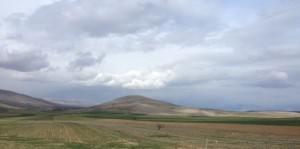
As we drive out of Pamukkale, with snow capped mountains on both sides, we pass marble quarries with huge slabs of marble stacked like building blocks on the side of the road.
Denizle is the main city of the area (300,000), known for its textile industry that makes use of the cotton grown in the area.
As we drive, Serder tells us the history of the Seljuk empire that later became the Ottoman Empire, and I jot down as much as I can, but this history comes with no guarantee of accuracy.
The Turks are descended from the Mongols. The 5 tribes ending in istan (Turkish for land of) Usbekistan, Turkmenistan, Kasakstan, etc. are mostly under Russian control today. There are 200 million Turkish speaking people in world (75 million in Turkey). It is same language group (Ural-Altaic) as Hungarian, Korean, Finish. There are 25,000 Turkish speaking people in northern China (the ones causing problems now). Great Wall of China built to keep our raids from northern tribes.
Early society was structured around family groups that lived in yurts or tents housing 8 family members who allied themselves with other families to form clans. When the leader of a clan died, his children fought to see who would control the clan. When Ghengis Khan died, his children fought, and the youngest took his tribe to India. His descendant built Taj Mahal to honor his wife.
In 600 AD ancestors of Turks moved west, mixing with people along way in Afghanistan, Syria, and Iran. The Seljuk Empire (an alliance of Persian, Arabs, and Turks) controlled all of Asia Minor and Middle East. They moved west, and in 1120 AD Seljuk took Konya and made it their capital. They expanded west into 14th century, all of Asia Minor controlled by Seljuk, except Constantinople, which they also eventually took under leadership of Otto who rejoined the warring tribes. The Seljuk and Ottoman are the same group, renamed for ruler who unified tribes.
The Seljuk built hotels for caravans (Caravanserai) every 30 miles along silk route along Central Anatolian Plane. It took 6 months to transfer goods from one end of Silk Road to the other.
The name Konya comes from a picture of a warrior on city gate, an icon, thus it became Konya, the city of the icon.
We pass a six foot deep lake of sodium sulfate (called the bitter lake), that is harvested and used in detergents and fertilizer.
We stop in Dinar, which was a large settlement in Hittite and Frygian period, so there are many rock tombs. Like much of the region, it is earthquake prone; in 2000 an earthquake destroyed half the town, but it was quickly rebuilt by the government because everyone in Turkey must pay earthquake tax as part of sales tax and everyone must carry compulsory earthquake insurance. They also grow poppies in this area, and they sell very think honey and very think yogurt mixed together with poppy seeds on top.
Where ever we stop (every 1.5 hrs), the bus is washed by the establishment, which is very grateful for the bus business because we always spend money. At this stop, I try the yogurt with honey (absolutely delicious), buy olive oil with rosewater soap, silk scarves, more sets of spices for Christmas presents, and a pair of hand knitted gloves Grand total 130 TL or $48.
Today we stopped for lunch at a restaurant offering your choice of prepared foods. Sedar will describe what each is, lots of eggplant and vegetable dishes, always a rice, and usually one of two meat dishes, lamb and beef or chicken. They also made gozleme, a crepe like pancake with cheese and or meat in it. I opted for lentil soup (5tl or $2.50). The lentil soup is dependably delicious, thick, and spicy. They bring bread to the table, so it is a filing meal.
The weather has turned cold and windy up here at 3000 feet, so we finally use the gloves and scarves we brought or bought.
Konya is the center of Sufi philosophy. Whirling Dervishes are considered a philosophic order. In 1207, Rumi was born in Afghanistan; he studied religion and traveled with father from Syria, to Iran, and settled in Konya. He came up with a philosophy of religion. All religions tell us different ways to get to god, but we don’t have to follow man made rules if our goal is love of god. His poetry uses two central metaphors. First, we all come from god, and like the planets that exploded away from sun, we are trying to get back to the sun (pretty sophisticated for 1200’s). The second metaphor is that a soul without love of god is meaningless, like a wind without purpose is nothing. A wind with purpose is like a flute. Rumi introduced music and whirling as central to meditation.
We visited the Rumi Museum in Konya, which houses his tomb and those of many of his followers as well as displays of many of the Sufi beliefs and customs. Both Ellie and I purchased CD’s of Sufi meditation music, which played throughout our visit to the museum and gardens, a haunting ethereal flute music.
In the Sufi costume, the hat represents the tombstone, the black coat represents the grave, and the white garments represents the shroud. They take the coat off, whirling to get back to god. One hand is up, and one hand is down, symbolically taking from god and giving to others. There are ten thousand dervishes in Turkey.
Apparently, the earliest settlements in Konya were in the neolithic period, and houses filled with painted walls were discovered and taken to the museum in Ankara, which we will see later in the trip.
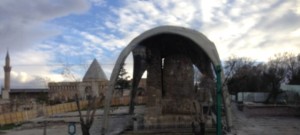
Protected bit of original mound city of Konya was founded on with tomb and mosque of Sultan Aladdin in background.
After we checked into our hotel,
Ellie and I ventured across the street to a shopping center to buy school supplies to take to a school we will visit tomorrow.




